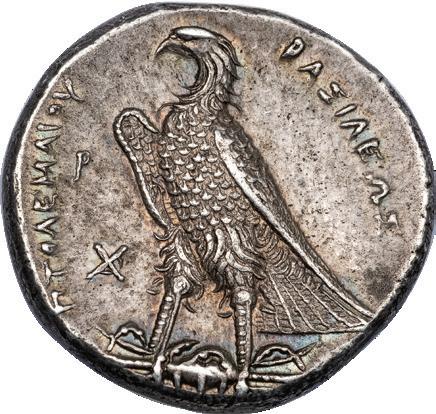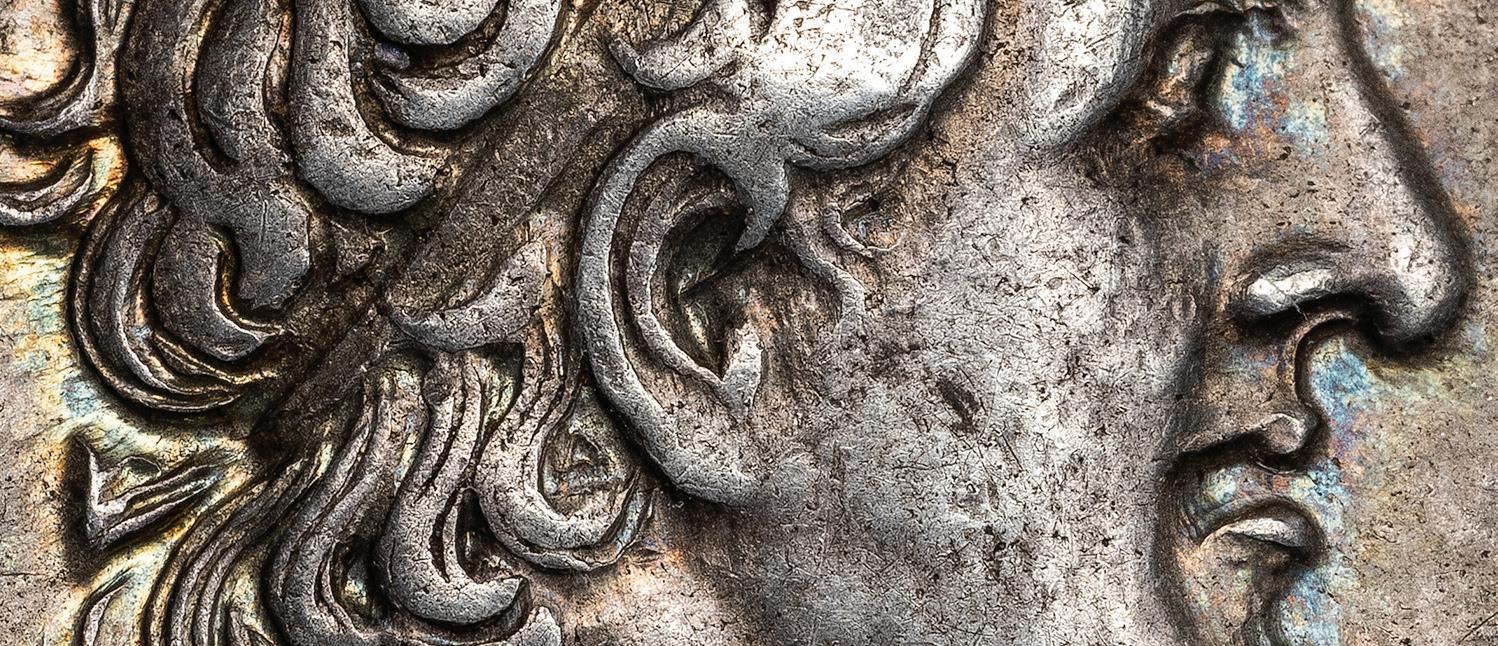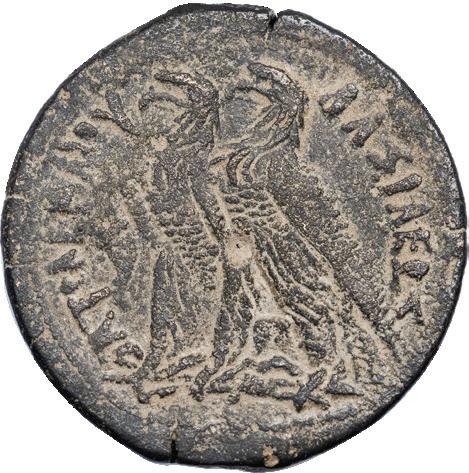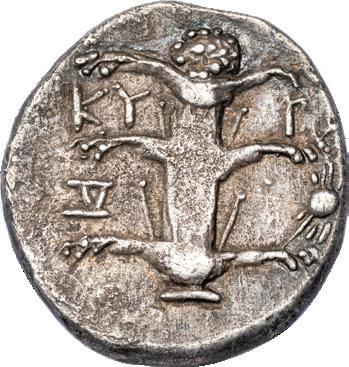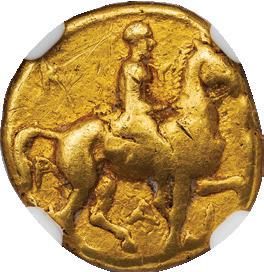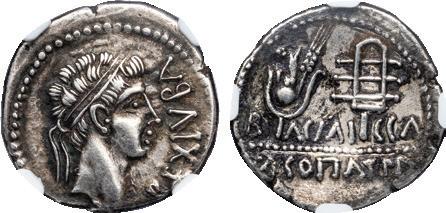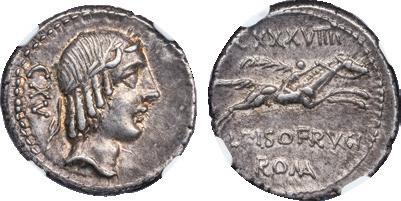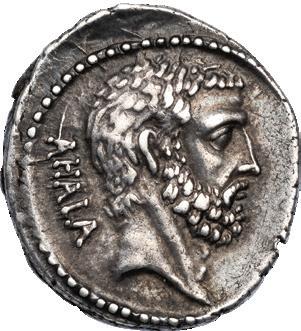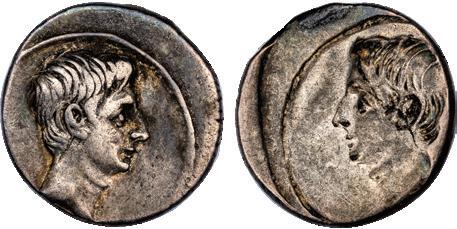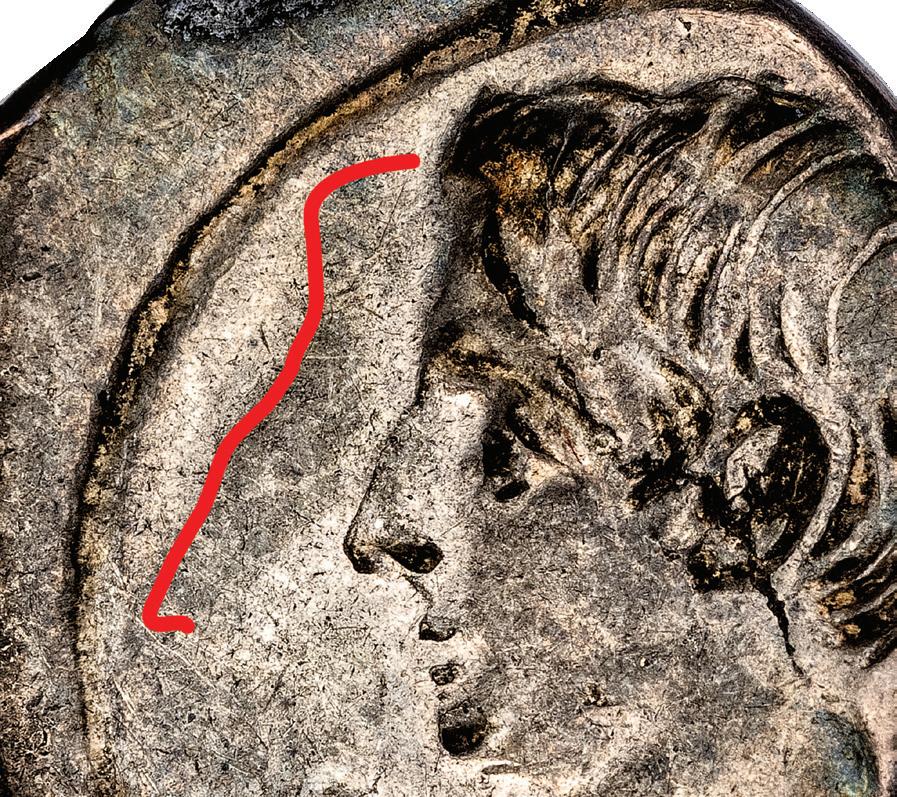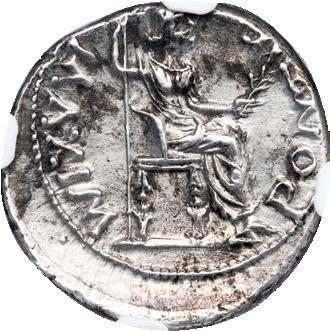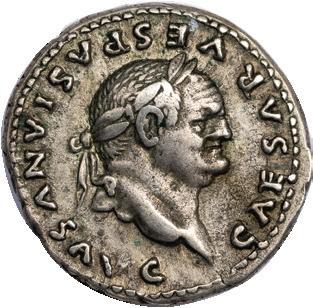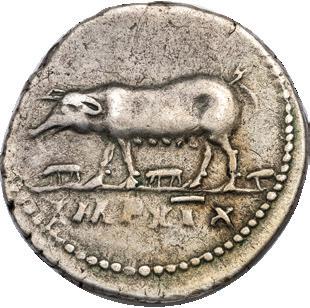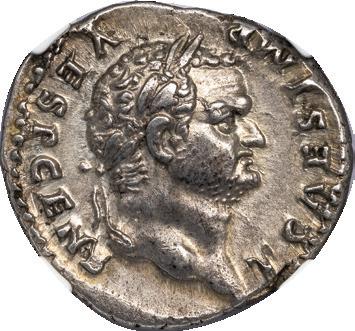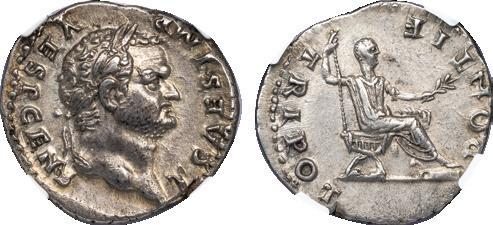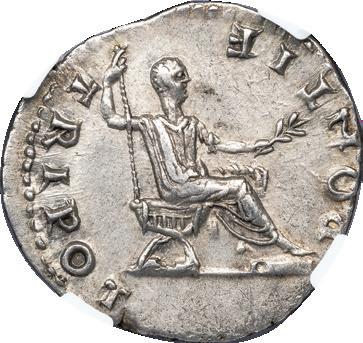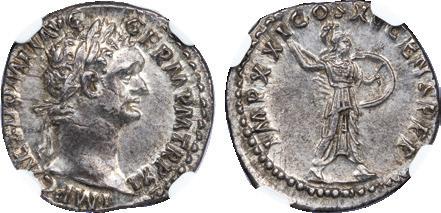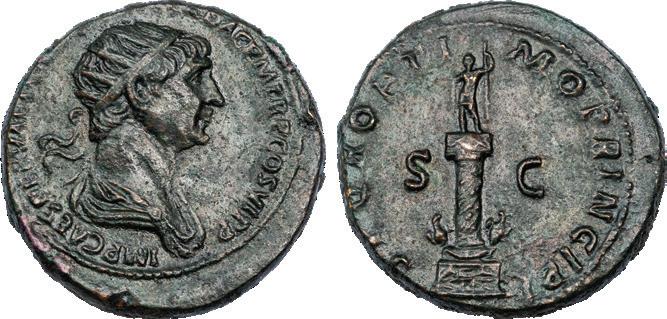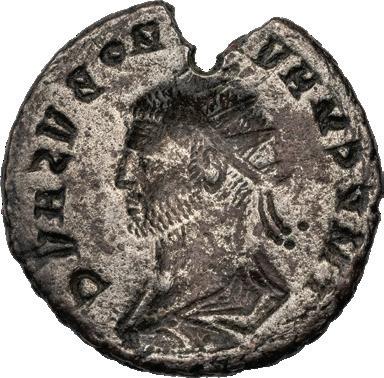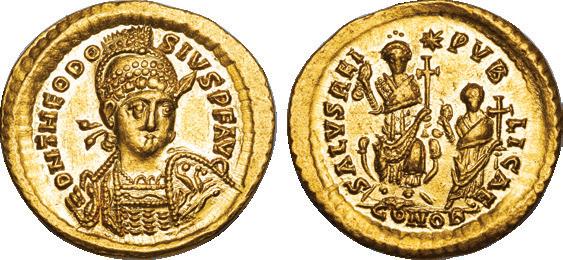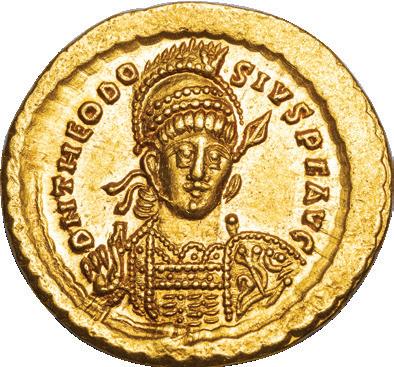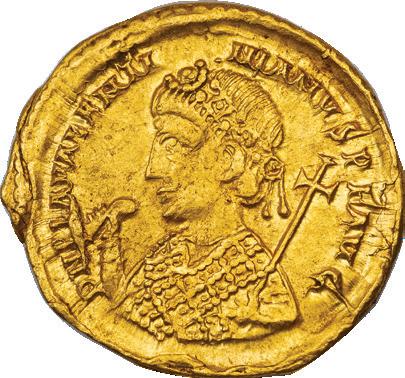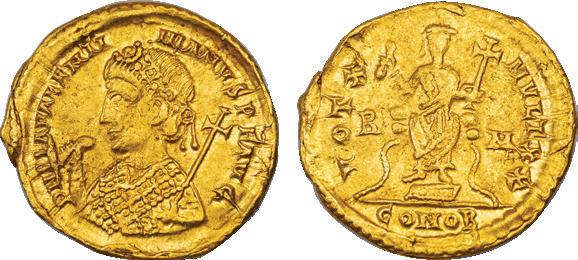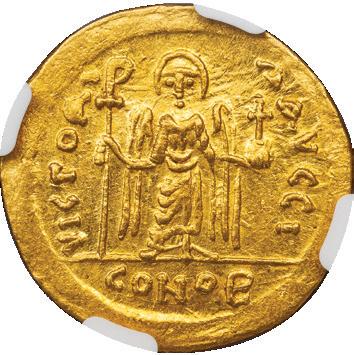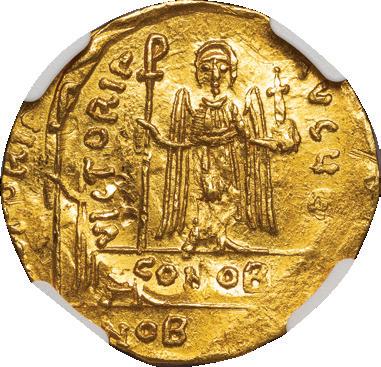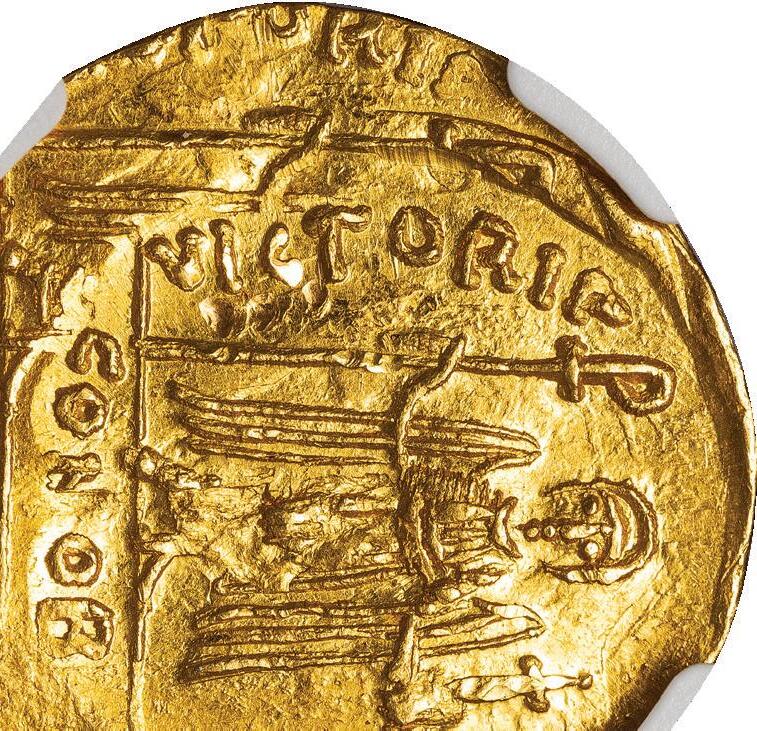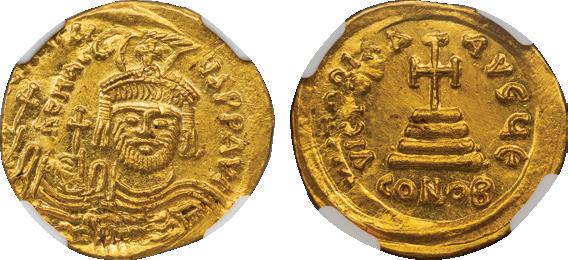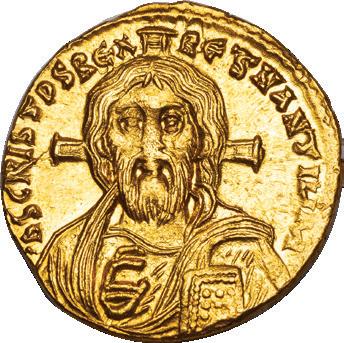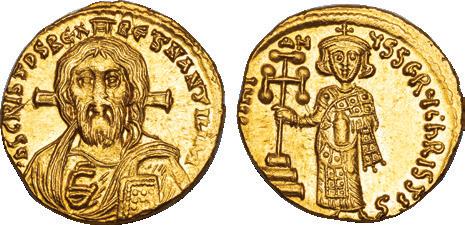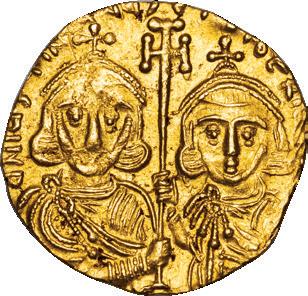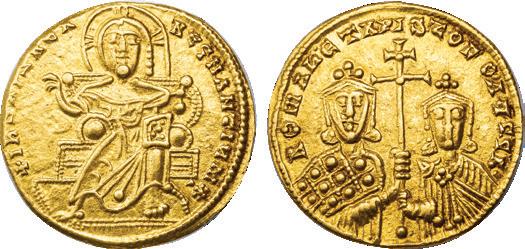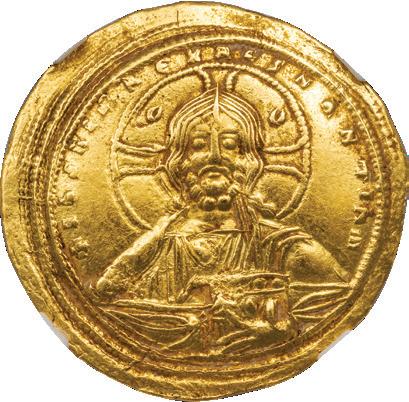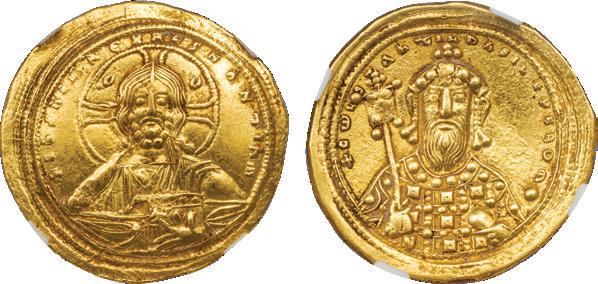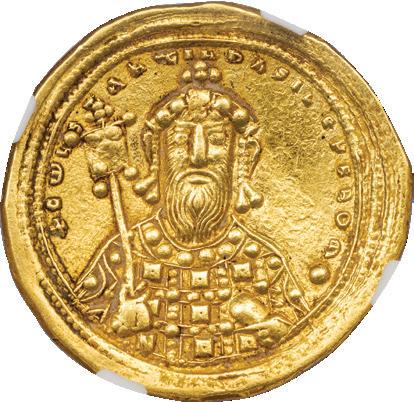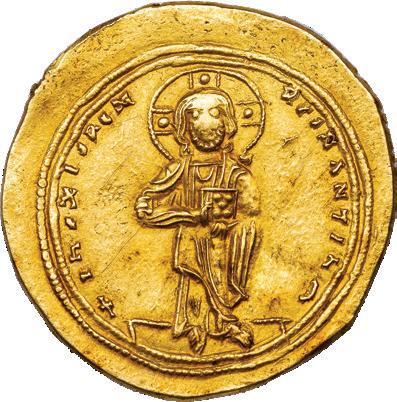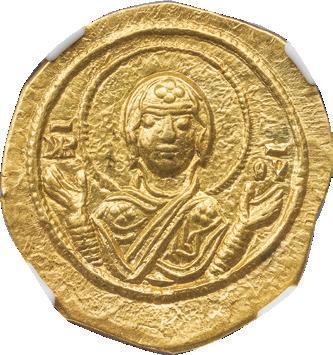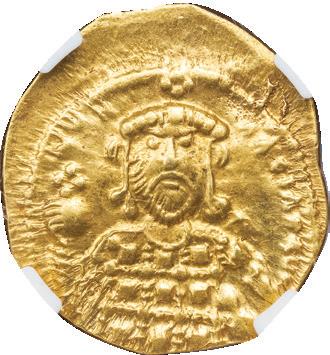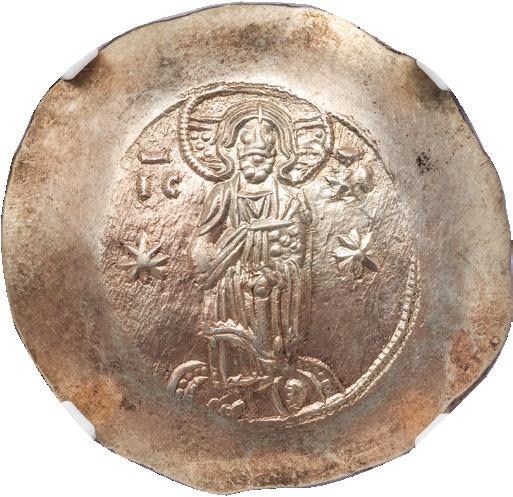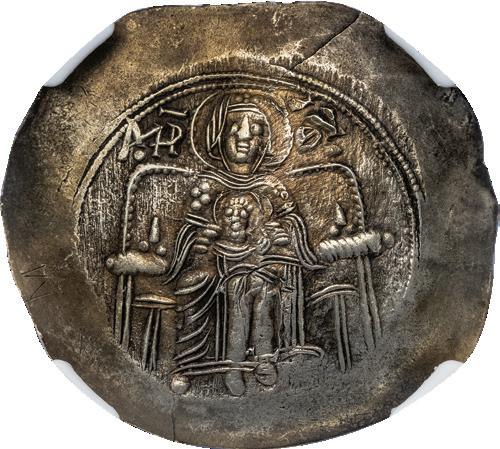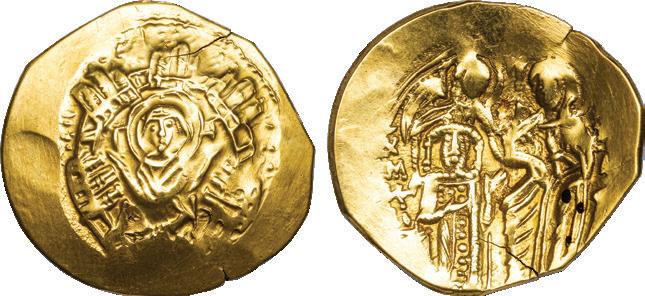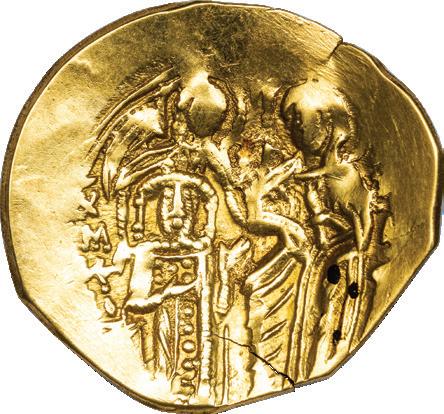VILMAR NUMISMATICSllc SHOWCASE VIII





ORDERING INFORMATION AND TERMS OF SALE
Email: vilmar@aol.com
(See our website for complete terms of sale and bibliographical information regarding abbreviations used.)
Please place your orders by email and refer to the inventory number provided at the beginning of each listing. The coins also appear as individual records on our website. All coins are offered subject to prior sale and no order is valid until confirmed by us in writing and accompanied by a formal invoice.
OUR GUARANTEE
We unconditionally guarantee the authenticity of all our coins. A coin may be returned for any reason within 10 days, but we ask that you first contact us and ship the piece back fully insured. Upon receipt of the return and providing it is in the same condition as originally sent out, we will issue a refund, minus any shipping and credit card charges. This guarantee does not apply if coins are removed from encapsulation.
NGC ENCAPSULATED COINS
Most of our coins are sold encapsulated in NGC holders. Such coins have been evaluated, graded, and encapsulated by NGC Ancients. NGC Ancients does not encapsulate any coins that in their opinion are fakes, of uncertain authenticity or have been repaired. In some cases, we offer raw coins, and these may be encapsulated upon request.
PAYMENT TYPES
Title does not pass until payment is made in full. Payment must be received within 7 days of the sale date. In the United States payment may be made by bank wire, money order or personal check drawn on a US bank. CREDIT CARDS (VISA, MC, AMEX) are generally accepted but an additional 4% service charge will be added. Payments from overseas (all foreign countries including Canada) may be made by bank wire.
SALES TAX
Sales tax will apply to all merchandise delivered within New York State and other select states as required.
SHIPPING CHARGES FOR COINS
United States: $50 for FEDEX or EXPRESS MAIL (delivery in 1–2 days within the US). Foreign, including Canada: $120 via fully trackable Fed Ex or USPS Global Express Mail. It is the responsibility of the buyer to comply with all customs regulations and pay for all duties/taxes in their country.
ILLUSTRATIONS USED IN THIS CATALOGUE
Coins are illustrated 1:1 and in various enlargements. In certain cases, we have also included images of older catalogues or publications wherein the specific piece is documented.
CREDITS
We are grateful to Oliver Hoover for his assistance in cataloguing and providing the historical notes, and to Mary Lannin for her editorial help. Photography and catalogue layout are the work of Alex Marinescu of Marinescu Designs, LLC.
WE WILL BE ATTENDING THE FOLLOWING COIN SHOWS AND LOOK FORWARD TO SEEING YOU
Whitman Baltimore Winter Expo, November 14–16, 2024
70th Annual FUN Convention, Orlando, FL, January 9–12, 2025
NYINC, Barclay InterContinental NYC, January 16–19, 2025




19392. GAUL. BELLOVACI. 1st century BC.
Bronze AE 17, 2.79 g, 17 mm.
Obv. Helmeted head (Roma?) to right within various patterns in field. Rev. Gryllos composed of a cock and the head of a man; various patterns in field.
DT 516; Allen –; Castekub –; Flesche –; Scheers –; de la Tour –.
Ex Chaponniere & Firmenich 15, 2022, 1 = iNumis auction 30, 10/13/2015, 70.
NGC graded CHOICE XF STAR, Strike 5/5, Surface 4/5, an extremely rare variant, especially in this exceptional condition.
$ 1350
The Bellovaci were a Belgic tribe of northern Gaul who joined with the neighboring Atrebates, Ambiani, Aulerci Eburovices, Caletes and Veliocasses in rising up against Roman domination in 57 BC. The Bellovaci, whom Julius Caesar described as “the bravest of all Gauls,” played a major role in the conflict—initially contributing 60,000 warriors to the Belgic coalition until 51 BC, when Caesar inflicted a devastating defeat on them and their chieftain was killed. Despite the strong opposition of the Bellovaci to the Romans, this rare coin illustrates the impact that Roman material culture was already having on the tribe. Unlike the somewhat more common “au coq” bronzes of the Bellovaci, which feature a Celtic head, the obverse of this piece depicts an abstracted head of Roma imitated from a Roman Republican denarius. The reverse is remarkable for the fantastic creature depicted there: a cock with its breast composed of the face of a Celtic warrior. Indeed, the skill of the die engraver has created an optical illusion in which the creature could also be interpreted as the head of a warrior wearing an elaborate cock–shaped helmet with the legs and claws of the bird forming his neck and shoulder.


19045. ROMAN IMPERATORIAL. L. HOSTILIUS SASERNA, 48 BC.
Silver Denarius, 3.86 g, 20 mm.

Obv. Head of a Gaul (perhaps Vercingetorix) with flowing hair to right, shield at left. Rev. [L HOSTILIVS] SASERN, Gallic warrior holding spear standing left in galloping biga right, driver holding reins and whip. Crawford 448/2a; Sydenham 952.
NGC graded XF, Strike 4/5, Surface 5/5. $ 2950
While the Roma–inspired obverse type of the preceding bronze coin of the Bellovaci reflects the Gallic gaze south, towards the invading Romans, the famous type of this denarius reflects the Roman gaze upon the defeated Gauls in the aftermath of the Gallic Wars (58–50 BC). The obverse of the denarius is widely believed to represent Vercingetorix, the last great Gallic chieftain to defy Rome. In early 52 BC, shortly after becoming king of the Arverni, Vercingetorix forged a coalition of Gallic tribes to drive the Romans out of Gaul, but in September of the same year he found himself defeated by Julius Caesar in the hard–fought Battle of Alesia. Still unbroken, Vercingetorix surrendered before he was taken to Rome to languish in prison for almost six years. At last, in 46 BC, he was brought out to march in Caesar’s great Gallic triumph before he was executed. The denarius reverse depicts the Celtic war chariot, an exotic weapon not normally used by continental Gallic peoples, but which the Romans first faced during the invasion of Britannia in 55 BC.


10853. CELTS OF THE DANUBIAN REGION. Ca. 3rd–2nd CENTURY BC.
Silver Tetradrachm of Alexander type, 15.05 g, 27 mm.

Obv. Head of young Heracles right in lion skin headdress. Rev. AΛΕΞΑΝΔΡΟΥ (in garbled letters), Zeus enthroned left, holding eagle and scepter, control monogram at left.
Kostial –; Lucank –.
NGC graded CHOICE VF, Strike 5/5, Surface 4/5.


10865. CELTS OF THE DANUBIAN REGION. Ca. 3rd–2nd CENTURY BC.
Silver Tetradrachm of Philip III type, 16.70 g, 27 mm.
$ 475

Obv. Head of young Heracles right in lion skin headdress. Rev. [OI]ΛΙIΠΠΟOV (in garbled letters), Zeus enthroned left, holding eagle and scepter, I control monogram at left.
Cf. Forrer, fig. 28, p. 18, pl. XXXIV; Kostial –; Lucank –.
NGC graded VF, Strike 5/5, Surface 4/5.
$ 450


11338. CELTS OF THE DANUBIAN REGION. Ca. 3rd–2nd CENTURY BC.
Silver Tetradrachm of Alexander type, 15.63 g, 25 mm.

Obv. Head of young Heracles right in lion skin headdress. Rev. –IOTΔNHΣΛ (in garbled letters), Zeus enthroned right, holding eagle and scepter, E in right field, H below throne.
Cf. Forrer, fig. 330, p. 172, pl. XXXIV, a specimen of similar style but with Zeus in the normal orientation; cf. Kostial 884, a tetradrachm with the obverse type reversed; Lucank –.
Ex Freeman and Sear Mail Bid 13, 8/25/2006, lot 58.
NGC graded CHOICE FINE, Strike 4/5, Surface 4/5, a particularly spectacular imitation, possibly unpublished, where the legend is entirely garbled, and the figure of Zeus is oriented to the right. $ 950

19912. SICILY. GELA. Ca. 465–450 BC.
Silver Tetradrachm, 17.01 g, 29 mm.


Obv. Charioteer driving quadriga right, Ionic column in background, grain stalk right in exergue. Rev. CEΛAΣ, protome of man–headed bull right.
Jenkins, The Coinage of Gela, 209 (O55/R112), a rare die pairing with Jenkins listing only two specimens, one in London, the other in a private collection in Palermo; HGC 2, 339.
Ex Gerald F. Borrmann Collection, acquired from Nilus Coins in May 2011, ex Numismatica Ars Classica Auction P, 5/12/2005, lot 1374.
NGC graded CHOICE VF, Strike 5/5, Surface 4/5, struck on a medallic planchet, edge splits, light gray tone. $ 3250
PUBLISHED

19914. SICILY. MESSANA. Ca. 425–413 BC.
Silver Tetradrachm, 17.35 g, 26 mm.


Obv. ΜΕΣΣ[ΑΝΑ], nymph Messana driving biga of mules left, pair of facing dolphins in exergue. Rev. ΜΕΣΣΑΝ, hare springing left, stalk of grain below.
Caltabiano, Monetazione, 511.6 (O205’/R212), this coin listed; HGC 2, 790; SNG ANS 372; SNG Copenhagen 403 (same dies); SNG Lockett 823 (same dies).
Ex Gerald F. Borrmann Collection, acquired from Dr. Arnold Saslow in June, 1986; ex Christie’s 10/8/1985, lot 8.
NGC graded XF, Strike 3/5, Surface 4/5, “flan flaw,” traces of overstriking which NGC regarded as a planchet imperfection, golden iridescent highlights. $ 3950

19878. SICILY. SYRACUSE. Ca. 485–470 BC.

Silver Tetradrachm, 17.09 g, 24 mm. Issue of ca. 485–479 BC.

Obv. Charioteer driving biga right, Nike, above, flying right, crowning horses. Rev. ΣΥΡΑΚΟΣΙΟΝ, diademed head of Arethusa right, four dolphins around.
Boehringer, Syrakus, 322 (V157/R225); HGC 2, 1306.
Ex Central Texas Collection, acquired from Nilus Coins, inv. 30800 (with his ticket).
NGC graded VF, Strike 4/5, Surface 4/5, late use of this die pair showing the distinctive die cracks on both obverse and reverse, gray cabinet patina. $ 1275


19883. THRACE. MARONEIA. 2nd–1st CENTURIES BC.
Silver Tetradrachm, 15.89 g, 33 mm.

Obv. Wreathed head of young Dionysus right. Rev. ΔIONYΣOY ΣΩTHPOΣ ΜΑΡΩΝΙΤΩΝ, Dionysus standing left, holding grapes and spears, cloak on left arm, control monograms flanking him.
Schönert–Geiss, Die Münzprägung von Maroneia, 1210 (O65/R214); HGC 3, 1556.
Ex CNG Electronic Auction 417, 3/28/2018, lot 30.
NGC graded AU, Strike 4/5, Surface 4/5.
$ 1500



18744. THRACIAN ISLANDS. THASOS. 500–450 BC.
Silver Stater, 9.03 g, 20 mm.
Obv. Ithyphallic satyr abducting nymph. Rev. Quadripartite incuse square.
Le Rider, Thasiennes, 1–2; HGC 6, 331.
Ex Lanz 106, 11/27/2001, lot 62.
NGC graded XF, Strike 5/5, Surface 3/5, “marks,” perfectly centered with exceptional detail of the facial features and physique of the two figures in the composition, including the well–endowed satyr. $ 2850


19867. THRACIAN ISLANDS. THASOS. 2nd–1st CENTURIES BC.
Silver Tetradrachm, 33 mm. Issue of Ca. 168/7–148 BC.
Obv. Wreathed head of young Dionysus right. Rev. ΗΡΑΚΛΕΟΥΣ

Heracles standing left, holding club, lion skin draped over left arm; M in inner left.
Prokopov, Silberprägung, Group IX, dies apparently unlisted; HGC 6, 359. Ex Central Texas Collection, acquired from Heritage 231640, 10/6/2016, lot 61008.
NGC graded CHOICE VF, light gray toning.
$ 575


19871. MACEDONIAN KINGDOM. PHILIP II, 359–336 BC.

Silver Tetradrachm, 14.40 g, 23 mm. Lifetime issue of Pella II A 2, ca. 342/1–337/6 BC.
Obv. Laureate head of Zeus right. Rev. ΦIΛIΠΠOY, youth on horseback right, wearing fillet, holding palm branch and reins, thunderbolt below, [N in exergue].
Le Rider 205 (D120/R167), citing 2 specimens of this die pair; HGC 3.1, 864.
Ex Central Texas Collection, acquired from Nilus Coins, inv. 30231 (with his ticket) = ex Agora Auctions 24, 1/13/2015, lot 37.
NGC graded CHOICE VF, Strike 4/5, Surface 3/5, “brushed.”



19872. MACEDONIAN KINGDOM. ALEXANDER III, THE GREAT, 336–323 BC.
Gold Stater, 8.54 g, 19 mm. Posthumous issue of Miletus, ca. 300–294 BC, struck under Demetrius Poliorcetes.
$ 1250
Obv. Head of Athena with a large Corinthian helmet, a snake ornament below the plume. Rev. ΑΛΕΞΑΝΔΡΟΥ, Nike standing facing looking to left, holding wreath in right hand and stylis over left shoulder, helmet crest in left field, double axe below left wing.
Price 2135; Thompson, Alexander Drachm Mints, vol. 1, Series IX, 226 (same dies); ANS 1944.100.31798 (same reverse die); Münzkabinett Berlin 18250178 (same dies).
Ex Central Texas Collection, acquired from Nilus Coins, inv. 30942 (with his ticket); ex Arpasi Collection, Pegasi Numismatics XXXIV, 5/23/2016, lot 92.
NGC graded XF, Strike 5/5, Surface 3/5.
$ 5250
A scarce variety with only 5 specimens in CoinArchives; the Pella database currently lists 5 specimens in public collections, including the American Numismatic Society, Münzkabinett Berlin (struck from the same dies), British Museum, National Numismatic Collection, De Nederlandsche Bank, Amsterdam, and the Bibliothèque nationale de France.


SEEMINGLY


19723. MACEDONIAN KINGDOM. ALEXANDER III, THE GREAT, 336–323 BC.

Silver Tetradrachm, 17.09 g, 27 mm. Early posthumous issue of a mint in the Levant or East.
Obv. Head of young Heracles right in lion skin headdress. Rev. ΒΑΣΙΛΕΩΣ
Zeus enthroned left, holding eagle and scepter, NK monogram above Δ in left field, X below throne.
Price unlisted, but cf C. Hersh, “Additions and Corrections to Martin J. Price’s ‘The Coinage in the name of Alexander the Great and Philip Arrhidaeus’” in Studies Price, no. 70 (monogram variety).
NGC graded CHOICE XF, Strike 5/5, Surface 4/5, “[unlisted in M. Price]”. $ 1500
This is part of a group of coins unknown to Martin Prince, though subsequently signaled in part by Charles Hersh. The defining feature is a K or NK control combined with different monograms in left field. Hersh listed a piece with K over ΔEI and HP. On CoinArchives there are several specimens that feature NK over ΔEI and HP on throne, such as CNG E198, lot 53. All of these, including the Hersh piece, were struck with the same obverse die. However, this seems to be the only specimen with this particular combination of controls, most of which appear recut in the die over earlier ones and struck with the same obverse die in what must be its final state.
REMARKABLE ROTATED DOUBLE STRIKE OF AN IMITATIVE ALEXANDER TETRADRACHM



19849. MACEDONIAN KINGDOM. ALEXANDER III, THE GREAT. Ca. 3rd–2nd CENTURY BC.
Silver Tetradrachm of Alexander type, 16.82 g, 28 mm. Imitative issue, possibly Celtic, based on Alexander issues of Amphipolis, ca. 315–294 BC.
Obv. Head of young Heracles right in lion skin headdress. Rev. ΑΛΕΞΑΝΔΡΟΥ (in somewhat atypical letters), Zeus enthroned left, holding eagle and scepter, Λ above race torch (?) in left field. Price B10.
VF, an impressive error, formerly encapsulated in NGC holder graded VF, “double struck with rotation,” an impressive error clearly showing the rotation of the strikes on both sides of the coin. $ 1200


19850. KINGDOM OF MACEDON. DEMETRIUS POLIORCETES, 306–283 BC.
Silver Tetradrachm, 17.12 g, 28 mm. Issue of Pella, ca. 306–283 BC.

Obv. Diademed head of Demetrius right with bull’s horns. Rev. ΒΑΣΙΛΕΩΣ ΔΗΜΗΤΡΙΟΥ, Poseidon standing left, holding trident, with foot raised on rock, EPΛ control monogram in outer left field.
Newell 89, obv. die LXVII; HGC 3, 1014a.
NGC graded CHOICE VF, Strike 4/5, Surface 4/5. $ 795


19865. MACEDONIA AS ROMAN PROVINCE (FIRST MERIS). Ca. 167–148 BC.
Silver Tetradrachm, 16.92 g, 33 mm.

Obv. Draped bust of Artemis right, within decorated Macedonian shield. Rev. ΜΑΚΕΔΟΝΩΝ ΠΡΤΗΣ, club right, ΣHATP control monogram above, TKP and TMYE controls below, all within wreath; thunderbolt left. Prokopov, Silver Coinage of the Macedonian Regions, 534 (O111/R420); HGC 3, 1103; SNG Copenhagen 1314 ff.
Ex Central Texas Collection.
NGC graded VF, Strike 4/5, Surface 3/5, “lt. scratches.”


19870. KINGDOM OF PAEONIA. PATRAUS, ca. 335–315 BC.

$ 750
Silver Tetradrachm, 12.58 g, 24 mm. Issue of Astibos or Damastion. Obv. Laureate head of Apollo right. Rev. YOAꟼTAΠ, helmeted and cuirassed warrior on horseback, spearing fallen soldier defending himself with spear and shield.
HGC 3.1, 148; Peykov E2180; SNG ANS 1040.
Ex Central Texas Collection, acquired from Pegasi Numismatics, inv. 11121224 (with old dealer’s ticket).
NGC graded XF, Strike 4/5, Surface 4/5.
$ 1200



19390. THESSALY. LARISSA. 5th CENTURY BC.
Silver Obol, 1.04 g, 12 mm.
Obv. Horse walking right, lion head above. Rev. LAPI, Larissa standing to right, holding hydria, behind at left a fountain with lion head spout from which water flows.
BCD Thessaly 1112; SNG Copenhagen 92.
Ex Rauch Sommerauktion 2012, 20 September 2012, lot 276.
VF, a very neat and decorative type (may be encapsulated upon request).


19866. THESSALIAN LEAGUE. 2nd–1st CENTURIES BC.

$ 650
Silver Stater (Double Victoriatus), 5.71 g, 21 mm. Issue of magistrates Damothoinos and Philoxenides, mid–late first century BC. Obv. Laureate head of Zeus right. Rev. ΘEΣΣAΛΩN, Athena Itonia striding right and preparing to throw spear, magistrate names above and in exergue.
BCD Thessaly 870.3; HGC 4, 210. Ex Central Texas Collection.
NGC graded AU, Strike 5/5, Surface 4/5, well struck with lustrous highlights.



19855. BOEOTIA, THEBES. Ca. 395–338 BC.
Silver Stater, 12.21 g, 22 mm. Issue of magistrate KAΛI–.
Obv. Boeotian shield. Rev. Amphora, KA–ΛI across field. Hepworth 62; BCD Boiotia 554; HGC 4, 1338.
$ 750
NGC graded CHOICE XF, Strike 5/5, Surface 4/5, a nicely centered and attractive piece with iridescent highlights, scarce magistrate with only 18 specimens listed on CoinArchives. $ 1350
Since the sixth century BC, the Boeotian shield had been the standard obverse type for the coinage of Thebes. Unlike the standard circular shield (hoplon) used by most Greek hoplites of the Classical period, the Boeotian shield was more oblong and easily distinguished by a cutout on the left and right sides – essentially representing a modernized version of the old figure–eight shields used by Mycenaean warriors of the Bronze Age and the Homeric epics.



19822. ATTICA. ATHENS. Ca. 440–404 BC.
Silver Tetradrachm, 17.20 g, 27 mm.
Obv. Helmeted head of Athena right. Rev. ΑΘΕ, owl standing right, head facing, olive sprig and crescent in left field, all within incuse square.
Kroll 8; SNG Copenhagen 31–40; Dewing 1591–1598; HGC 4, 1597.
NGC graded MINT STATE Strike 5/5, Surface 5/5, nicely struck on a generous planchet, with full 5/5 ratings. $ 2850



19869. ATTICA. ATHENS. Ca. 440–404 BC.
Silver Tetradrachm, 17.14 g, 24 mm.
Obv. Helmeted head of Athena right. Rev. ΑΘΕ, owl standing right, head facing, olive sprig and crescent in left field, all within incuse square.
Kroll 8; SNG Copenhagen 31–40; Dewing 1591–1598; HGC 4, 1597.
Ex Central Texas Collection, acquired from Nilus Coins, inv. 31133 (with old dealer’s ticket).
NGC graded MINT STATE Strike 5/5, Surface 3/5. $ 1800



19876. ATTICA. ATHENS. Ca. 353–294 BC.
Silver Tetradrachm, 17.00 g, 21 mm.
Obv. Helmeted head of Athena right, eye in profile. Rev. ΑΘΕ, owl standing right, head facing, olive sprig and crescent in left field. Kroll –; HGC 4, 1599.
Ex Central Texas Collection, acquired from Nilus Coins, inv. 31133, (with old dealer’s ticket).
VF, minor marks (may be encapsulated upon request). $ 375


19886. ATTICA. ATHENS. 2nd–1st CENTURIES BC.

Silver “NEW STYLE” Tetradrachm, 16.55 g, 27 mm. Issue of ca. 119/8 BC, under magistrates Dionysi–, Dionysi– and Zeuxi–, with control symbol Helios in quadriga.
Obv. Helmeted head of Athena right, within dotted border. Rev. A–ӨE, owl standing right, head facing, magistrates’ names (ΔIO–NYΣ, ΔIONYΣI, ZEYΞI) in fields, Helios facing, driving his quadriga in lower right field, Z (month) on amphora, ? in exergue, all within wreath.
Thompson 566c (same obverse die); HGC 4, 1602.
Ex Central Texas Collection, acquired from Nilus Coins, inv. 30086 (with old dealer’s ticket).
NGC graded CHOICE VF, Strike 5/5, Surface 3/5, “graffito,” this particular combination of magistrates that includes Zeuxi– is rare, Thompson lists 10 specimens across various die combinations and CoinArchives lists only one such specimen. $ 850
TURTLE OVER TURTLE?



19852. ISLAND OF AEGINA. Ca. 525–480 BC.
Silver Stater, 12.31 g, 21 mm.

Obv. Sea turtle with shell showing a thick collar, its beaked head turned left. Rev. Punch with “Union Jack” pattern. Meadows, Group IIb; HGC 6, 430.
NGC graded VF, Strike 5/5, Surface 3/5, “edge marks,” glossy dark gray cabinet toning, distinct traces of overstriking.
$ 1800
Although MacDonald, Overstruck Greek Coins (Atlanta, 2009), does not include any Aeginetan overstruck pieces, this coin displays characteristic traces of an undertype on the obverse and some minor traces (lines) on the reverse. While it is difficult to be certain, it may well be that this coin was struck over a “proto–tortoise” of Meadows Group Ib, whose massive form was compressed into the oval shape we notice under the present sea turtle. There are certainly other examples of overstruck Aegina turtles including CNG 40, 12/4/1996, lot 1014 and Nomos Obolos 33, 9/8/2024, lot 276.


19102. CORINTHIA. CORINTH. EARLY–MID 4th CENTURY BC.
Silver Stater, 8.35 g, 21 mm.

Obv. Pegasus flying left, koppa below. Rev. Head of Athena left, wearing Corinthian helmet, hand grasping torch in left field. Pegasi 115 (same reverse die); ANS inv. 1944.100.36725 (same reverse die).
NGC graded CHOICE XF, Strike 4/5, Surface 3/5, “brushed,” high–relief strike with pleasing light gray toning, a rare variety that depicts only the hand with torch symbol (as opposed to Pegasi 116, another and more common variant that also includes a bucranium in lower right field).
$ 3750



19891. CORINTHIA. CORINTH. 4th CENTURY BC.
Silver Stater, 8.54 g, 20 mm.
Obv. Pegasus flying left, koppa below. Rev. Head of Athena left, wearing Corinthian helmet, Γ below chin, filleted thyrsus in right field. Pegasi 417; HGC 4, 1848.
Ex Central Texas Collection acquired from Nilus Coins, inv. 30733 (with old dealer’s ticket).
NGC graded CHOICE XF, Strike 5/5, Surface 4/5. $ 1250



19523. ELIS. OLYMPIA. Ca. 336–324 BC.
Silver Hemidrachm, 2.66 g, 16 mm. Issue of the Hera mint for the 111–114th Olympiad, ca. 336–324 BC.
Obv. Head of nymph Olympia left, Δ below neck. Rev. Eagle standing left, F A and grape bunch on vine in right field.
BCD Olympia 193 (same dies); HGC 5, 448 (same dies illustrated); SNG Lockett 2431 (same dies).
NGC graded CHOICE FINE, Strike 5/5, Surface 2/5, “marks,” rare variety. $ 475



19854. ELIS. OLYMPIA. Ca. 256–240 BC.
Silver Hemidrachm, 2.33 g, 15 mm. Issue for the 131–135th Olympiad, ca. 256–240 BC.
Obv. Laureate head of Zeus right. Rev. F–A flanking winged thunderbolt, all within olive wreath.
BCD Olympia 355.5 (same dies); HGC 5, 512.
Ex CNG Electronic Auction 209, 4/22/2009, lot 143.
NGC graded CHOICE FINE, Strike 5/5, Surface 4/5. $ 650
The head of Zeus on the coin is likely based on that of the famous chryselephantine (gold and ivory) colossal cult statue of Zeus from the Temple of Zeus at Olympia. It was executed in the Greek Classical period by the famous sculptor Phidias who claimed to have been inspired by the verses of Homer describing Zeus: “The son of Cronos spoke, and bowed his dark brow in assent, and the ambrosial locks waved from the king’s immortal head; and he made great Olympus quake.” [Iliad 1, 538–540]


19888. AEOLIS. CYME. Ca. MID–2nd CENTURY BC.
Silver Tetradrachm, 16.29 g, 32 mm. Issue signed by magistrate Seuthes.

Obv. Head of the Amazon Cyme right. Rev. KYMAIΩN, horse to right, cup below, ΟΛΥΜΠΙΟΣ in exergue, all within laurel wreath. Oakley, obverse die 52; Boston MFA 1651 (same obv. die); Pozzi 2302 (same obv. die).
Ex Central Texas Collection, acquired from Nilus Coins, inv. 29330 (with old dealer’s ticket).
NGC graded CHOICE XF, Strike 5/5, Surface 3/5, “brushed.”
$ 1500
FROM THE 1972 BANK LEU SALE AND PUBLISHED IN SACKS’ STUDY OF MYRINA


19887. AEOLIS. MYRINA. Ca. MID–2nd CENTURY BC.
Silver Tetradrachm, 16.28 g, 33 mm.

Obv. Laureate head of Apollo right. Rev. MΥΡINAIΩN, Apollo Grynios right, standing, holding branch and phiale, omphalos and amphora at his feet, ΓΒΝ control monogram in left field, all within laurel wreath. Sacks, Issue 29, 33l (this coin listed).
Ex Central Texas Collection, acquired from Nilus Coins, inv. 30534, with old dealer’s ticket; ex Bank Leu 2, 4/25/72, lot 235.
NGC graded CHOICE XF, Strike 4/5, Surface 4/5, light gray cabinet patina, a coin published in Sack’s seminal article on the series. The piece has been professionally cleaned since its appearance at the Bank Leu 1972 sale, to remove a large patch of unsightly encrustation on the obverse. $ 2750
THE MYTH OF ACTAEON THE HUNTER



19903. LESBOS. MYTILENE. Ca. 454–427 BC.
Electrum Hecte, 2.45 g, 10 mm.
Obv. Head of Actaeon right with stag’s horn. Rev. Facing Gorgon head. Bodenstedt 54; HGC 6, 980
NGC graded CHOICE VF, Strike 4/5, Surface 4/5; a mythological type depicting the hunter Actaeon as he was transformed into a stag by a vengeful Artemis and left to become prey for his own dogs. $ 1550


19474. IONIA. ISLAND OF CHIOS. CIVIC

ISSUE WITH THE TYPES OF ALEXANDER THE GREAT, ca. 290–220 BC.
Silver Tetradrachm of Alexander type, 17.08 g, 31 mm. Posthumous issue of Chios, ca. 270–220 BC.
Obv. Head of young Heracles right in lion skin headdress. Rev. ΑΛΕΞΑΝΔΡΟΥ, Zeus enthroned left, holding eagle and scepter, Archaic sphinx seated on base right above AV monogram in left field.
Price unlisted, but cf. Price 2367 = Mektepini Hoard 308, Bauslaugh series 33, struck from the same obverse die; another specimen of the AV issue struck from the same obverse die appears in Lanz 132, 11/27/2006, lot 150.
NGC graded CHOICE VF, Strike 5/5, Surface 4/5, “[unlisted in M. Price],” extremely rare and apparently known in only 2 specimens.
This interesting variety seems to have been unknown to Price, who catalogued related issues with the characteristic archaic looking sphinx seated on a base to right (Price 2366–2367). It certainly belongs with these as the same obverse die of Price 2367 was employed here. $ 1650

19904. IONIA. EPHESUS. PHANES, ca. 625–600 BC.
Electrum 1/24 Stater, 0.58 g, 7 mm.


Obv. Forepart of stag right, head turned to left. Rev. Incuse with linear designs. Cf. Weidauer 36–37 (1/12 stater); SNG von Aulock 7773; Linzalone LN1105.
NGC graded CHOICE VF, Strike 4/5, Surface 4/5. $ 3750
A historical coin, this piece is a smaller denomination belonging to the series issued by Phanes, an individual otherwise unknown in the historical record. The stater and trite are signed with Phanes’ name and are the very first coins to bear a legend and a personal name. The lower denominations, such as this piece, feature variations on the famous stag emblem that is identified as the “badge” of Phanes on stater. A Phanes hemihecte from this series was found at the Artemision of Ephesus in a late 7th century archaeological context – see White Gold, no. 28, pp. 98, 128–130, making these among the very first coins ever struck.


19320. IONIA. EPHESUS. Ca. 4th CENTURY BC.

Silver Tetradrachm, 15.26 g, 25 mm. Issue of magistrate ΔHMAΓOPHΣ (Demaroges), ca. 360–350 BC.
Obv. E–Φ, bee seen from above, within dotted circle. Rev. Forepart of stag right, palm tree at left, ΔHMAΓOPHΣ (magistrate) in right field.
Kinns, Pixodarus, Class F, p. 203, obverses 88–90, 92. This specimen is struck from an unrecorded obverse.
NGC graded CHOICE VF, Strike 5/5, Surface 3/5. $ 2700

19351. IONIA. PHOCAEA. Ca. 477–388 BC.
Electrum Hecte, 2.54 g, 10 mm.


Obv. Facing head of old Silenus wearing ivy wreath, seal at left (off flan). Rev. Quadripartite incuse square. Bodenstedt 67.
NGC graded CH XF, Strike 5/5, Surface 3/5, FINE STYLE, very nicely struck and attractive. $ 1950
UNLISTED IN PRICE, ONE OF TWO SPECIMENS KNOWN



19480. IONIA. SMYRNA. CIVIC ISSUE WITH THE TYPES OF ALEXANDER THE GREAT, ca. LATE 3rd CENTURY BC. Silver Tetradrachm of Alexander type, 16.96 g, 32 mm. Issue of ca. 220–200 BC.
Obv. Head of young Heracles right in lion skin headdress. Rev. ΑΛΕΞΑΝΔΡΟΥ, Zeus enthroned left, holding eagle and scepter, head of Tyche left above MAYPΩ control monogram in left field.
Price unlisted, but the monogram is probably related to that of Price 2257 which appears to be a simplified variant of the same letters. NGC graded CHOICE XF, Strike 5/5, Surface 4/5, FINE STYLE, “[unlisted in M. Price].” CoinArchives lists only one other specimen, ex Gemini XI, 1/12/2014, lot 53. $ 2350
The Alexanders of Smyrna are very elusive and there are many undocumented varieties. This particular one was unknown to Price, although it conforms well to the series and should be placed in the sequence somewhere around Price 2257. It appears to be one of two specimens on record.
AN EARLY SCARAB ELECTRUM HECTE

19683. IONIA, UNCERTAIN MINT. Ca. 650–600 BC.
Electrum Hecte, 2.25 g, 10 mm.


Obv. Uncertain type, possibly a scarab beetle. Rev. Bipartite incuse punch.
K. Konuk and C. Lorber, White Gold: Revealing the World’s Earliest Coins, 36 = Linzalone 1110 (trite, described as a ram); SNG Kayhan 673.
NGC graded AU, Strike 4/5, Surface 4/5, here the eyes are quite distinct and on the sides of the design there are elongated features that recall the insect’s legs.
$ 1250


19880. CARIA. ISLAND OF RHODES. Ca. 250–230 BC.
Silver Didrachm, 6.65 g, 21 mm.

Obv. Radiate head of Helios facing slightly right. Rev. ΤΙΜΟΘΕΟΣ, rose with one bud, herm left field, P–O at bottom. Ashton 209; SNG Keckman 540541; SNG von Aulock 2808; BMC 1502; HGC 6, 1329.
Ex Central Texas Collection, acquired from Nilus Coins, inv. 29996 (with old dealer’s ticket).
NGC graded CHOICE XF, Strike 4/5, Surface 4/5, “marks,” boldly struck in high relief.


19877. PAMPHYLIA. ASPENDUS. Ca. 380–325 BC.
Silver Stater, 11.00, g, 22 mm.
$ 975

Obv. Two wrestlers in combat, AK between. Rev. EΣΤFEΔΙΙΥΣ, slinger to right, ready to shoot, triskeles in right field, all within dotted square.
Tekin Series 4; SNG von Aulock 4561; SNG Copenhagen 231; SNG France 84.
Ex Central Texas Collection, acquired from Nilus Coins, inv. 30842 (with old dealer’s ticket).
NGC graded CHOICE XF, Strike 4/5, Surface 3/5, “countermark, brushed,” the circular countermark is carefully applied to the reverse, away from the design, and seems to depict a roaring lion’s head. $ 850



19882. PAMPHYLIA. ASPENDUS. CIVIC ISSUE IN THE NAME AND TYPES OF ALEXANDER THE GREAT, ca. 212–181 BC. Silver Tetradrachm of Alexander type, 16.88 g, 34 mm. Issue civic year 11 (ca. 202/1 BC).
Obv. Head of young Heracles right in lion skin headdress. Rev. ΑΛΕΞΑΝΔΡΟΥ, Zeus enthroned left, holding eagle and scepter, AΣ above IA (date) in left field.
Price 2891.
Ex Central Texas Collection, acquired from Nilus Coins, inv. 30783 (with old dealer’s ticket).
NGC graded CHOICE VF, Strike 4/5, Surface 3/5, “brushed,” an attractive, moderately circulated specimen with great eye appeal. $ 480


19949. PAMPHYLIA. PERGE. Ca. 3rd CENTURY BC.
Silver Tetradrachm, 15.44 g, 30 mm.

Obv. Head of Artemis right, bow and quiver behind, all within dotted border. Rev. APTEMIΔOΣ ΠEPΓAIAΣ, Artemis standing left, stag standing left looking at goddess, I in inner left field.
Colin Series 2, Emission 10 (dies 5.2/15.4); SNG France 330; SNG von Aulock 4659.
NGC graded CHOICE VF, Strike 5/5, Surface 3/5, “scuff,” dark tone.


19803. SELEUCID KINGDOM. SELEUCUS I, 312–281 BC.

Silver Tetradrachm of Alexander type, 17.33 g, 28 mm. Issue of Seleucia on the Tigris, ca. 295 BC.
$ 950
Obv. Head of young Heracles right in lion skin headdress. Rev. ΣEΛEYKOY BAΣIΛEΩΣ, Zeus enthroned left, holding Nike who crowns him, complex control monogram in left field.
SC 119.8a; ESM 22; HGC 9, 16f.
Ex CNG Electronic Auction 448, lot 192 = New York Sale VII, 1/15/2004, lot 1003 = M&M Numismatics FPL 2, 1998, no. 66. NGC graded XF, Strike 4/5, Surface 3/5, M&M provenance noted on label, original find patina on one side, golden highlights.


19733. SELEUCID KINGDOM. SELEUCUS I, 312–281 BC.

$ 750
Silver Tetradrachm of Alexander type, 17.20 g, 28 mm. Issue of Uncertain Mint I, in Cappadocia, Eastern Syria, or Northern Mesopotamia, ca. 294–281 BC or even bit later.
Obv. Head of young Heracles right in lion skin headdress. Rev. ΣEΛEYKOY BAΣIΛEΩΣ, Zeus enthroned left, holding eagle, ΛY in left field, ΔI under throne.
SC 50.3; WSM 1333; HGC 9, 12b.
NGC graded CHOICE XF, Strike 4/5, Surface 3/5, struck from a worn obverse die, the reverse die engraved in a schematic, almost barbarized style, characteristic of this series.
$ 450




19856. SELEUCID KINGDOM. SELEUCUS I, 312–281 BC.

Silver plated “fourrée” Tetradrachm, 14.46 g, 27 mm. Issue of an uncertain mint, based on an issue of Susa, ca. 305/4–295 BC. Obv. Head of Seleucus right, wearing helmet with panther skin covering and bull’s ears and horns. Rev. BAΣIΛEΩΣ ΣEΛEYKOY, Nike standing right, crowning trophy, AY control monogram in left field, ΓΑY control monogram in center field.
SC 173.5b (for prototype); HGC 9, 20 (for prototype). Cf. SC II, P29 (a plated issue with same types but different monograms) as well as Elsen 147, 6/4/2021, lot 91 for a lower grade specimen of the same issue but from different dies.
Good XF/AU, some scratches on the obverse, a spectacular strike with full details, exceptionally bright and lustrous, silver cladding intact except for some small areas on the obverse where the bronze core may be seen (may be encapsulated upon request). $ 3500
The Susian trophy coinage of Seleucus I seems to have enjoyed a great deal of popularity in the Iranian territories of the Seleucid empire both during his lifetime and after. Hoard evidence indicates that they even continued to circulate in Persis after the displacement of direct Seleucid authority by the local Frataraka rulers in the early third century BC and local fractions with the Susian trophy types were struck in the name of Antiochus I in Drangiana (SC 226–228). This popularity spawned a variety of imitations of varying degrees of quality, some of which were produced as fourrée with silver surface plating over a bronze core. Only a single plated tetradrachm was published in the plated coinage appendix to Seleucid Coins, Part II (P29) and since then only seven more have appeared on CoinArchives. Of these, five copy the control monograms of SC 173.12–14, suggesting that this series was the preferred model for the fourrées. The present tetradrachm is apparently the third known example of a plated issue with the controls of SC 173.5 (the others were Elsen 147, 6/4/2021, lot 91, same issue as above but from different dies, and Pars 6, 4/20/2020, lot 57), very similar controls and from different dies as well). All known Susian trophy tetradrachm fourrées are struck from imitative dies (the Pars coin is mistakenly described as having been struck from Kritt’s official obverse die A65) although some are executed with a very high degree of skill. As one would expect, the present piece does not employ any of the official dies illustrated in the studies by Kritt or Marest–Caffey, but its engraver was clearly an individual of exemplary skill. It also shares its obverse die with a fourrée tetradrachm sold in Baldwin’s 68, 9/28/2010, lot 3434, which features the control monograms of SC 173.14). This is an extremely important die link because it shows that fourrées with different monogram sets were produced at the same facility and raises questions about the producers. Were they simply sophisticated counterfeiters who used multiple prototypes for their dies, or could they possibly have belonged to a distinct mint with some official sanction, striking fourrées to meet an emergency?


19885. SELEUCID KINGDOM. ANTIOCHUS VI, 144–142 BC.

Silver Tetradrachm, 16.63 g, 30 mm. Issue of Antioch on the Orontes, dated Seleucid era year 170 (143/2 BC).
Obv. Radiate and diademed head of Antiochus VI right. Rev. BAΣIΛEΩΣ ANTIOXOY EΠIΦANOYΣ ΔIONYΣOY, the Dioscuri on horseback left, OP (date) below horses, TPY above XAP monogram above ΣTA in right field, all within wreath of laurel, ivy leaves, grain ears and lotus blossoms.
SC, 2000.3b; SMA 242; HGC 9, 1032.
Ex Central Texas Collection, acquired from Nilus Coins, inv. 31055 (with old dealer’s ticket).
XF, hints of colorful toning on the obverse; a scarce variety with some 4 specimens on CoinArchives and ca. 13 pieces on SixBid Classical Archives (may be encapsulated upon request). $ 1950
Antiochus VI Dionysus, a child who was probably about nine years old in 143/2 BC, when this attractive tetradrachm was struck, had been promoted by the general Diodotus Tryphon to challenge the hated Demetrius II Nicator in 144 BC. Thanks to growing popular support for the boy, the revolt engineered by Tryphon at Apamea quickly allowed for the expulsion of Demetrius II from Antioch and the placement of Antiochus VI on the throne in the Syrian capital. Unfortunately, by the time this tetradrachm was produced at Antioch, Tryphon was becoming tired of the child figurehead king and plotted to take power for himself. Early in the next year, 142/1 BC, Antiochus VI died under suspicious circumstances while undergoing surgery and Tryphon became king. The reverse type, which features the Dioscuri rather than typical Seleucid deities like Apollo and Zeus, seems to consciously set the reign of Antiochus VI apart from those of other Seleucid kings, especially that of Demetrius II. At the same time, the unusual wreath combining, ivy, grain and flowers on the reverse associates him with Dionysus, a prominent god at Apamea, the epicenter of the revolt that placed Antiochus VI on the throne.


19810. SELEUCID KINGDOM. DEMETRIUS II, 129–125 BC.
Silver Tetradrachm, 16.49 g, 29 mm. Issue of Antioch on the Orontes, 129–128 BC.

Obv. Diademed and bearded head of Demetrius II. Rev. BAΣΙΛΕΩΣ ΔHMHTPIOY ΘEOY NIKATOPOΣ, Zeus enthroned left, holding Nike, Ξ in outer left field, Δ below throne.
SC 2166.2a; HGC 9, 1117b.
NGC graded CHOICE VF, Strike 5/5, Surface 3/5, with a great portrait of the king. $ 850
This coin was struck immediately after the return of Demetrius II to Antioch following years of living in distant Hyrcania as an honored captive of the Parthian kings Mithradates I and Phraates II. As Demetrius’ brother, Antiochus VII Sidetes, mounted a great but doomed campaign against the Parthians in 129 BC, Phraates II released Demetrius to create chaos in Antiochus’ rear. Demetrius II briefly reclaimed the Syrian capital, but his coins struck there and at other cities reveal that his captivity had changed him. His hairstyle and beard may reveal the influence of Parthian culture on the restored king while the stubby horn depicted at his temple hints at megalomania and deification. After all, his personal epithet declared him to be Theos Nikator (“the Victorious God”).
Among the only ancient coins graded by PCGS


19797. PHOENICIA. TYRE. 126/5 BC–ca. AD 65/6.
Silver Shekel, 25 mm. Issued dated Tyre year 165 (AD 39/40).

Obv. Laureate head of Melkart right. Rev. ΤΥΡΟΥ ΙΕΡΑΣ ΚΑΙ ΑΣΥΛΟΥ, eagle standing left on prow, ΡΞΕ (date) above club in left field, KP above NPA monogram in right field, Phoenician letter A between legs.
DCA Tyre Supplement Release 2, 612.
VF, seemingly overstruck or double struck, in old PCGS holder (13327175) labeled “Shekel of Tyre – Thirty Pieces of Silver – Genuine.” Year 165 is rare, with only 7 pieces on CoinArchives. $ 2250
This shekel was part of a group of 600 Tyrian shekels and half shekels slabbed by PCGS as a promotion ca. 2006. The promotion was organized by dealer Jonathan K. Kern, who guaranteed the coins were genuine. The pieces of this exceptional promotion represent the only instance when PCGS has encapsulated ancient coins.
Struck in the
last decade of christ’s life



19726. PHOENICIA. TYRE. 126/5 BC–ca. AD 65/6. Silver Shekel, 14.12 g, 24 mm. Issue of an uncertain year in the last decade of CHRIST’S LIFETIME, likely Tyre Year 150 (AD 24/25). Obv. Laureate head of Melkart right. Rev. TYPOY IEPAΣ KAI AΣYΛOY, eagle standing left on prow, PNZ (date) above club in left field, KP above control monogram in right field, uncertain Phoenician letter between legs.
DCA Tyre Supplement Release 2, 565 (same obverse die).
Ex Harlan J. Berk 171, October 2010, lot 189.
NGC graded CHOICE VF, Strike 4/5, Surface 4/5, “uncertain year, AD 20s–30s.” $ 2700
Because of the very schematic style of dies used to strike shekels during the latter part of Christ’s lifetime, the specific year is sometime difficult to make out as it is often composed of dots and dashes. However, a more precise chronological range is available from the obverse die that struck the coin. Here the obverse is encountered on coins of Tyre year 150 = AD 24/25 (Cohen, Tyre 2, 539) as well as year 157 = AD 31/32 (Cohen, Tyre 2, 565, 567–569). Given the similarity in form of the reverse control monogram to that illustrated by Cohen for year 150, it is likely that this emission may be placed at that time as well.
























